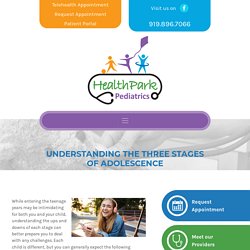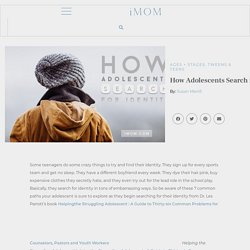

Module 2.1s Adolescent development: The art of growing up. Understanding the Three Stages of Adolescence - HealthPark Pediatrics. While entering the teenage years may be intimidating for both you and your child, understanding the ups and downs of each stage can better prepare you to deal with any challenges.

Each child is different, but you can generally expect the following changes during the three stages of adolescence as outlined by the American Academy of Pediatrics. Each stage is separated into lists of both physical and mental/emotional changes. Ages 10 to 13: Early Adolescence Physical Growth & Development. 11 to 13 years old (Early adolescence) 14 to 17 years old (Middle adolescence) 18 to 21 years old (Late adolescence) Adolescent Identity Development: What to Expect in Teens. Adolescent Identity Development: The Factors of Change Among the profound and exciting changes taking place in adolescence is the process of self-discovery.

Our teens are working to figure out who they are, making adolescent identity development a central feature of teen life. Young people’s identities are shaped by lots of factors — family, cultural and societal expectations, experiences with institutions like school and the media, and friends. Young people also take active steps and make choices that shape their identity. They select the environments and people they want to be around. Based on the youtube video...... Youtube. In Erik Erikson's psychosocial development theory...... 8 stages of psychosocial development. Erik Erikson's Stages of Psychosocial Development. Erik Erikson was an ego psychologist who developed one of the most popular and influential theories of development.
While his theory was impacted by psychoanalyst Sigmund Freud's work, Erikson's theory centered on psychosocial development rather than psychosexual development. The stages that make up his theory are as follows:1 Let's take a closer look at the background and different stages that make up Erikson's psychosocial theory. Overview. 8 Stages of Development by Erik Erikson. Identity vs Role confusion in Adolescents. Identity vs Role confusion in Adolescents. Finding own identity...... How Adolescents Search for Identity - iMom. Menu Search Close Share what kind of mom you are!

Get to know other mom types! How Teenagers Find Themselves. Teens are notoriously self-conscious.

Now brain-imaging experiments are revealing how this adolescent predilection might be the result of changes in brain anatomy linked with the self, and the findings may hint at how the sense of self develops in the brain. One way we build a sense of self is by reflecting on how others perceive us, a concept psychologists have dubbed “the looking-glass self.” To see how teenagers reacted to what other people thought of them, researchers asked adolescent girls ages 10 to 18 to imagine a variety of scenarios involving onlookers that were designed to evoke social emotions such as guilt or embarrassment—for example, “You were quietly picking your nose, but your friend saw you.” It makes evolutionary sense for teenagers to be highly concerned about what others think, Blakemore suggests. Adolescence requires becoming more independent because one’s parents might not be around much longer. References.